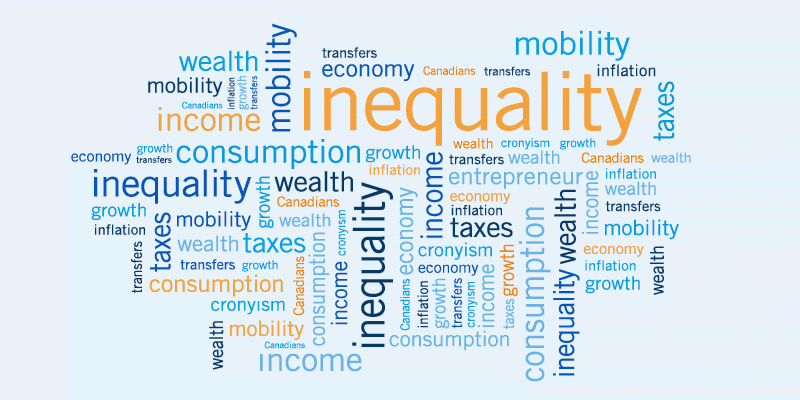Towards a Better Understanding of Income Inequality in Canada

In recent years, income inequality has become one of the most animating—and unfortunately most misunderstood—economic and social issues of our time. Sparked by the 2008-09 recession, the well-deserved backlash against corporate bailouts, the Occupy Wall Street movement, and a deluge of reports pointing to a growing problem, income inequality has vaulted to the forefront of the public’s concerns.
Several analyses conclude that income inequality is rising with increasingly larger shares of income being concentrated among the highest earners. Such conclusions depend on the data and assumptions being used to measure inequality. Indeed, many prominent international and Canadian researchers continue to use flawed and incomplete data and research methods to fuel concerns of a growing “income gap” and stagnating standards of living.
This is why we need a better understanding of the true nature of inequality and income growth, including whether inequality is necessarily harmful, how sensitive the inequality measures are to the underlying definitions, whether or not there really is a rapidly growing gap, and the state of income mobility, which is the ability of Canadians to rise out of their respective income group over time. The chapters in Towards a Better Understanding of Income Inequality in Canada tackle these issues and offer a comprehensive analysis of income inequality.
The book begins by pointing out that individuals earn income and accumulate wealth in dramatically different ways. It is essential this fact be taken into consideration in any understanding of the nature of income and wealth inequality. Chapter 1 explains that when measuring inequality, we can’t simply compare countries such as Canada, where typically businesses and entrepreneurs only prosper by benefiting society, to countries where cronyism and government-granted privileges are widespread and rig the system to the benefit of elites. Before determining how much any society should worry about inequality, citizens should first understand that the way income and wealth are earned is critical.
Chapter 2 comes to the conclusion that, when measured properly, income inequality has not been growing rapidly in Canada. When income inequality in Canada is measured improperly, discussions about it are misleading. For example, earnings (wages and salaries) represent a narrow definition of income, yet many researchers use only earnings to measure income inequality, which ignores a number of critical factors including government transfers (welfare, Old Age Security, etc.) to low-income families. This chapter also addresses the question of who should be measured—individuals or families and concludes that the most accurate measurement for income inequality is after-tax income (which includes government transfers) adjusted for family size.
Chapter 3 finds that inequality in the standard of living of Canadians (consumption inequality, or the difference in spending by different households) has barely changed in 40 years. Consumption—compared to income—better reflects Canadians’ actual economic well-being by measuring what people do buy to support a certain standard of living, and not what people could buy, based on their income.
Chapter 4 points out that wealth inequality in Canada is largely the result of people’s age differences. Wealth accumulation is a process. It happens slowly and steadily over a long period. Canadians usually acquire the most wealth when they hit their peak earning years—between 55 and 69—just before retirement. When they retire, they start to draw down savings and, in effect, become less wealthy again. What’s more, wealth inequality in Canada has actually declined over the past four decades.
Just as wealth is accumulated over the course of decades, so too is the level of income that Canadians earn each year. Chapter 5 explains that Canada’s high level of income mobility means that very few Canadians remain stuck in low income. The vast majority of those in the lowest income group move up the income ladder over time, which is the mark of a dynamic economy.
A repeated claim in the inequality debate is that the middle class in Canada is stagnating. But this is untrue. Chapter 6 demonstrates that middle-class incomes are up dramatically in Canada since the 1970s. Not only have middle-class incomes risen dramatically, the purchasing power of those incomes goes a lot further today than back in the 1970s. Canadians have to work fewer hours today in order to afford similar and often higher quality household goods.
So much of the debate around income inequality revolves around perceptions of fairness. The book’s final chapter discusses the proposition that inequality could be solved if governments increased taxes on upper income earners. This “solution” is based, in part, on a mistaken impression that the country’s top earners are paying relatively little tax. Governments have fuelled this misperception by invoking “tax fairness” to justify higher taxes on upper earners. Canada’s top income earners currently pay a disproportionate share of taxes relative to the share of income that they earn and that tax ratio gap has been increasing over time. The imbalance is primarily due to the progressivity of Canada’s personal income tax system, which taxes higher levels of income at higher marginal tax rates. Those who advocate higher taxes on top income earners are, in effect, arguing that those earners should be paying an even more disproportionate share of taxes.
Taxes cannot be continually raised on top income earners without economic consequences. Higher tax rates would further erode Canada’s tax competitiveness, discourage economically productive activity, hinder the country’s ability to attract and retain top talent, and dampen the incentives for income mobility. Once that happens, everyone is hurt, particularly those, ironically enough, whom the misguided policies are intended to help.
Income inequality is a complex issue. The good news is that the problem of inequality isn’t nearly as bad as people are sometimes led to believe. Canadians have less inequality than they might think, and are more able, thanks to opportunities of mobility, to get out of a low-income situation than they might fear. Middle-class incomes in this country are not stagnating, and most people can and do build wealth over the course of their lives. The bad news is that policies designed to address inequality might be doing more harm than good—exacerbating the situation and making it worse, not better.
Authors:
More from this study
Subscribe to the Fraser Institute
Get the latest news from the Fraser Institute on the latest research studies, news and events.










